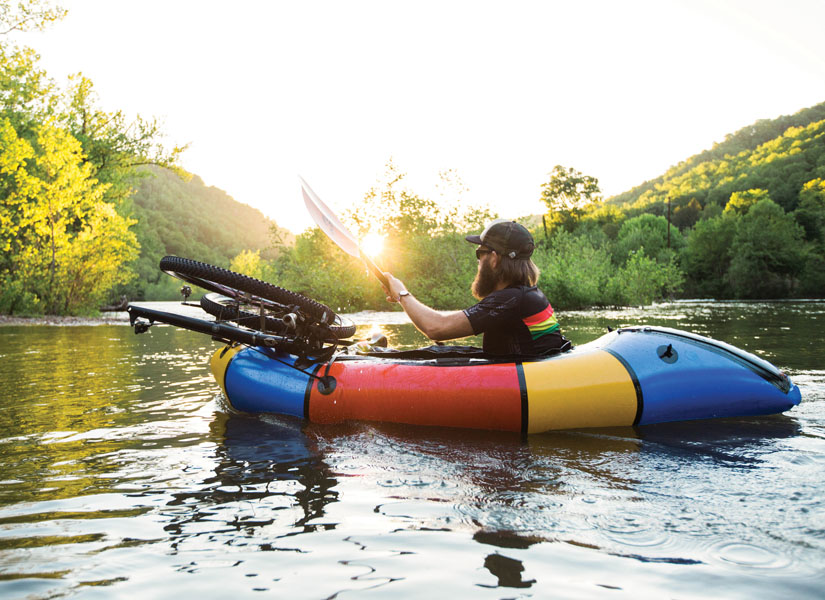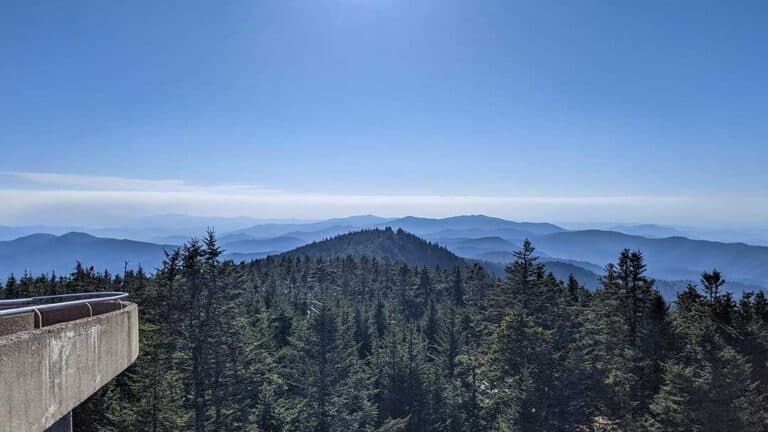The concept of lugging portable, one-man rafts isn’t new to the world of adventure sports. Backpackers in the western United States and Alaska have been using this versatile mode of river transportation for decades. But as packraft technology has continued to improve in the past few years, so, too, have the possibilities for multisport river adventures.
I have one person to blame for tempting my adventure itch with a packrafting trip. New River Bikes owner Andy Forron.
A few months back, a photo popped up on my Facebook feed. It was a picture of Andy’s bike partially disassembled, strapped to the bow of a peculiar looking raft, floating against a backdrop of the New River Gorge Bridge at dusk.
“Time for a whole new level of multisport,” the caption read.
A paddler and cyclist at heart, that’s when I knew I wanted in on this packrafting thing. It was the perfect marriage of two worlds I never expected could overlap. In the past, I had certainly seen plenty of inflatable kayaks on the river, but never a packraft and definitely not a packraft with a bike secured to its bow. If these one-man rafts were so popular elsewhere in the country, why not here in the Southeast and Mid-Atlantic where the paddling season is longer and warmer?
The Adventure
Thus, the idea of a bikepacking packrafting (say that five times fast) trip was born. After securing a couple of Alpacka packrafts from Packraft America for myself and our third partner-in-grime, Annie Simcoe, the only thing left to figure out was the route.
I’d like to say that we spent hours together pouring over maps, orchestrating the perfect three-day, two-night ride-to-float, but the fact of the matter is that Andy, our de facto local and guide, literally threw the route together at 11 o’clock the night before. Of course, Andy had been scheming this trip long before I ever approached him about it, so plotting the actual route on a GPS was a mere courtesy to Annie and me.
The plan? Ride from Fayetteville to Richwood, W.Va., on over 100 miles of low-traffic country roads, gravel roads, and rail-trails until we arrived at the banks of the Top Gauley. From there, we would inflate our rafts and head downstream to where Route 19 crosses Summersville Lake, at which point we would pack up the rafts and ride 20 breezy miles back to town.
Like any good adventure, our trip was destined for trouble before we even left. More than four inches of rain had dumped on southern West Virginia in the days leading up to our departure, and more was expected on day two of our journey. But when I finally mounted my loaded bike after a sheet-twisting sleepless night, rain was the last thing on my mind.
Day One
The morning dawned crisp and cool. We rode single file over the New River Gorge Bridge, which hummed with the morning commute. As I gazed at the New flowing big and brown below, it was hard to believe that this trip had been the result of Andy’s packraft picture—the raft, the bike, the bridge. It was all unfolding beneath my very pedals.
Soon, we veered onto Lansing Road and away from the screaming semis on Route 19. Within the hour we were cruising with ease along the loose gravel of the Meadow River Trail. When we popped out of the forest, giddy with glee, we were met with the sobering sight of Nallen, a now mostly abandoned community that had been all but wiped away in last year’s historic flood. Dates and high water lines were scratched above the blown out windowpanes of singlewides, a somber homage to a still-fresh calamity.
We started climbing almost immediately and, with the exception of a few downhill reprieves, continued climbing well into the afternoon. Neighborhoods gave way to bucolic farmscapes. We passed through the unincorporated community of Nutterville, which was nothing more than a pocket of homes and one-room churches. Over the course of three hours, the only traffic that passed was a rusty tractor and a Jeep.
By early evening, we had arrived in the old coal town of Quinwood, population 285. With 30-odd miles yet to go, we restocked our water and candy supply at the B&M Grocery. Two guys in camo lingered outside by a four-wheeler. Feeling self-conscious in my lycra and neon yellow gloves, I hung by the bikes while Andy asked for better directions to the Beech Ridge wind turbines. Their input proved invaluable, shaving off eight roundabout miles of even more climbing.
As the sun began to settle below the trees, we finally crested Beech Ridge. For a while, we marveled at a whirling wind turbine looming some 400 feet above us. Its breeze cooled the sweat on my back. We pedaled on, landing at a flat patch of forest along an overgrown logging road to camp for the evening.

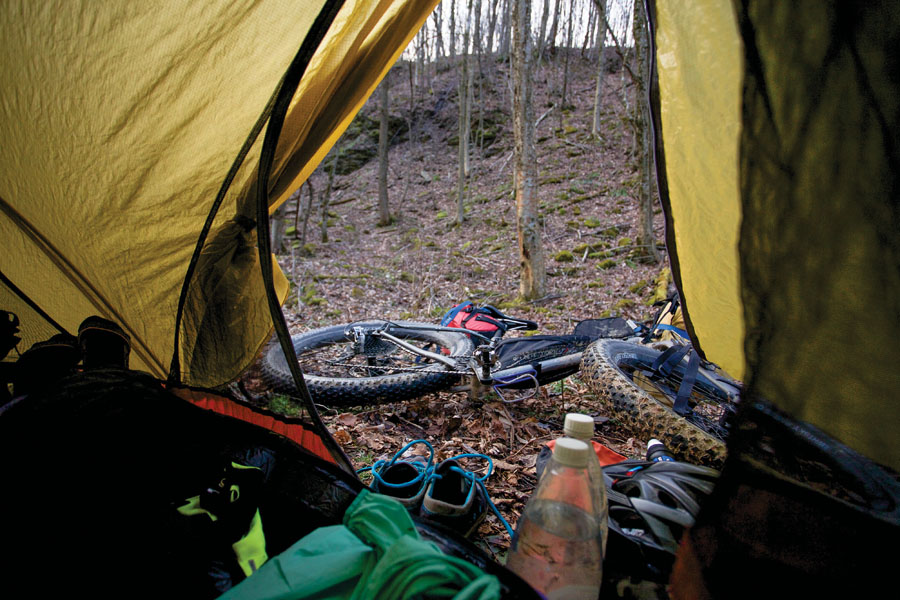
Day Two
Braced for rain, we woke to a pleasantly dry and warm day. My legs felt used, but not spent. The next 11 miles were mostly downhill as we followed the Cherry River into Richwood. Had I known what the afternoon would bring, I might have had a beer when we pulled into the Mountaineer Mart.
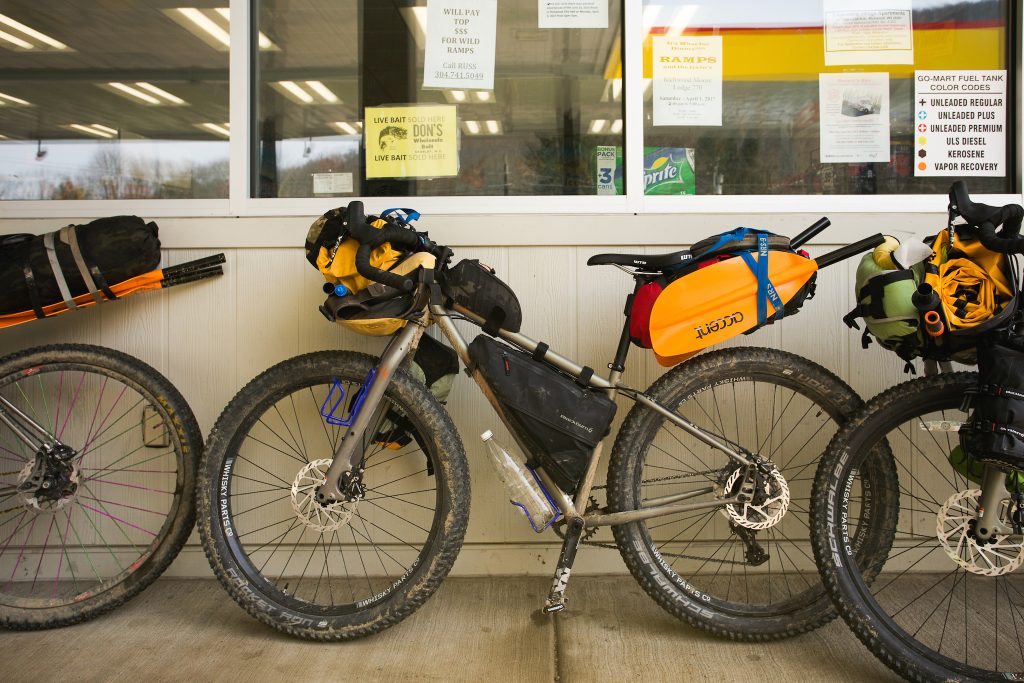
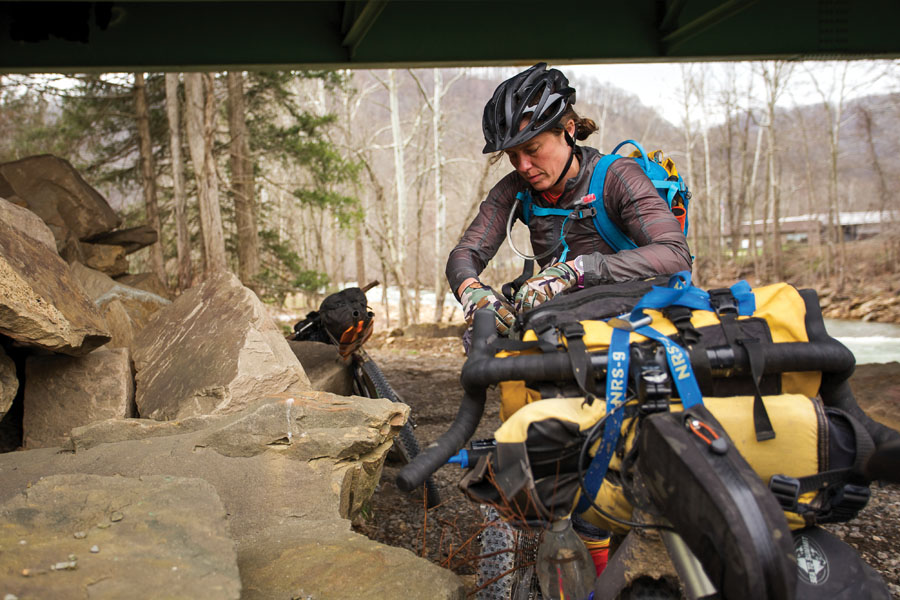
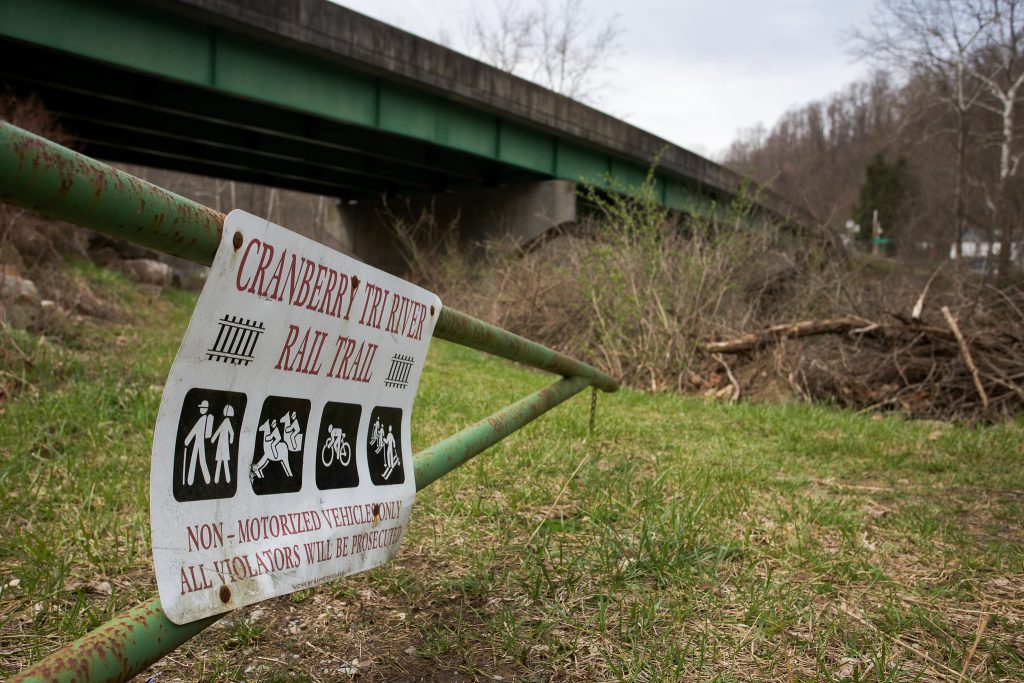
By 2 o’clock, the rain was falling in heavy sheets. We had long turned off WV-55 at the confluence of the Cherry and Gauley Rivers and onto an access road of questionable integrity. At first we passed by summer camps and rental homes, but before long, it was just the three of us, our bikes, and the raging river to our right. One by one we navigated around mud puddles ranging in size from small potholes to lane-wide craters. The going was slow, but enjoyable. We were wet already—what difference did splashing through a mud puddle make?
But the overgrown rail bed continued to deteriorate. Bigger, deeper mud craters impeded efficient riding for miles on end. The soul sucking, muddy sand pits stopped my bike dead in its tracks and I fell twice in knee-deep water the color of heavily creamed coffee.
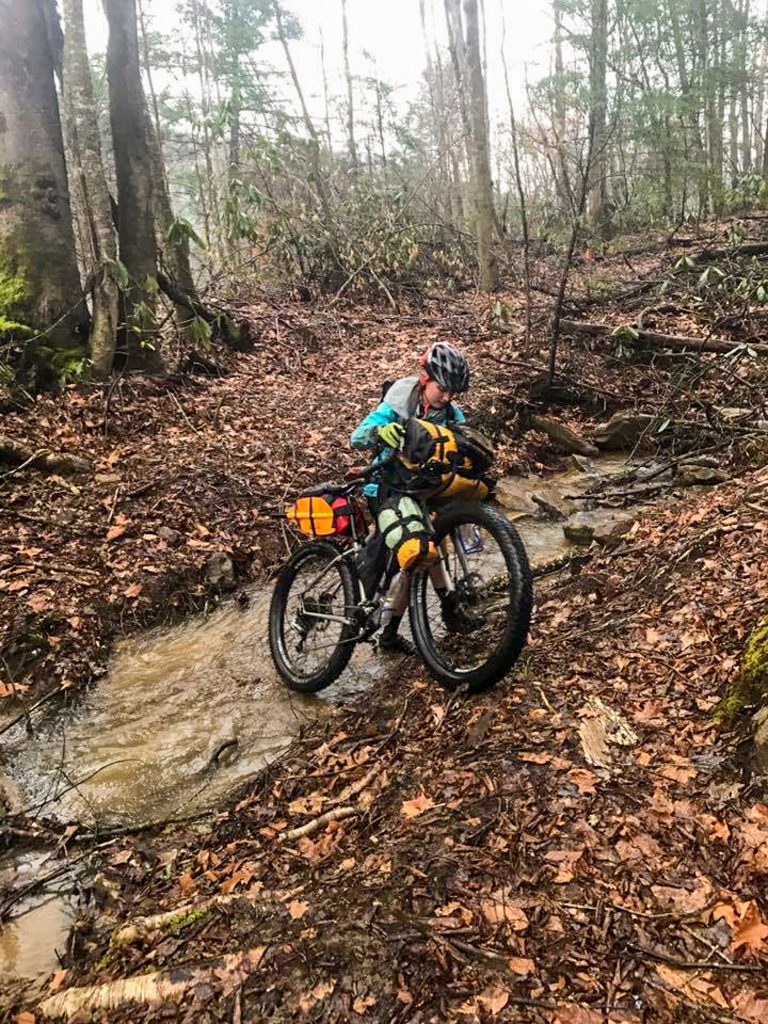
The “road,” if you can call it that, was littered with leaves and fallen branches. I desperately looked to the river in hopes of finding a nice beach to launch our packrafts from, but the bank was steep, and the swollen Gauley River flowing high in the trees. We trudged on, slogging through stream crossings and picking our way over long stretches of baby head rocks.
Eventually, we hit the literal end of the line. To our right was an unfortunately trashed, but level, riverside campsite. To our left, an impossibly steep four-wheel “road” (I use that term loosely) that climbed up and out of the river valley. We had a decision to make—float into the unknown on a flooded river, or hike-a-bike out of there.
It was nearing dinnertime, and with no idea of what lay downstream, we hopped off our bikes and started to climb. For a mile-and-a-half, we pushed our 50-pound bikes up 700 feet out of the valley. In many places, the road was completely washed out, and in others, so rocky and steep as to hardly warrant being called a road.
When we reached rideable terrain again, we mounted our bikes once more with a weary determination to camp as close to Summersville Lake as possible. Thankfully, the rain clouds parted. As we cooked dinner and reflected on the 100 miles we’d traveled so far, the gray sky melted to night in a brilliant swirl of stormy mauve, the color of my bruised legs.
Day Three
During the night, a thunderstorm rolled in. Even with my eyes closed I could see the bright flashes of lightning strike the ridgeline. A light drizzle still spat intermittently in the morning, but we weren’t concerned with being wet anymore. It was our final day.
Within minutes of leaving camp, I got a flat tire and Annie realized her paddle was missing a connector piece. No matter. After two days of lugging packrafts and paddles and PFDs up and over mountains, we were determined to paddle, no matter the obstacle. We changed the flat, stabilized Annie’s paddle with some tent stakes and zip ties, and proceeded to load up the packrafts.
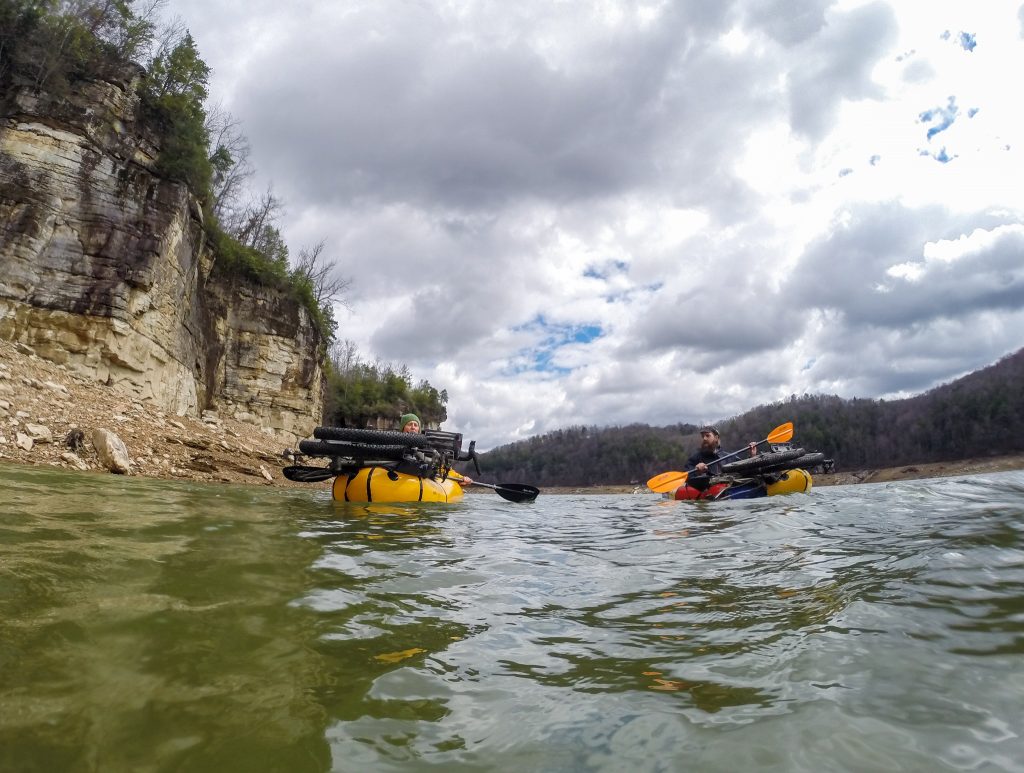
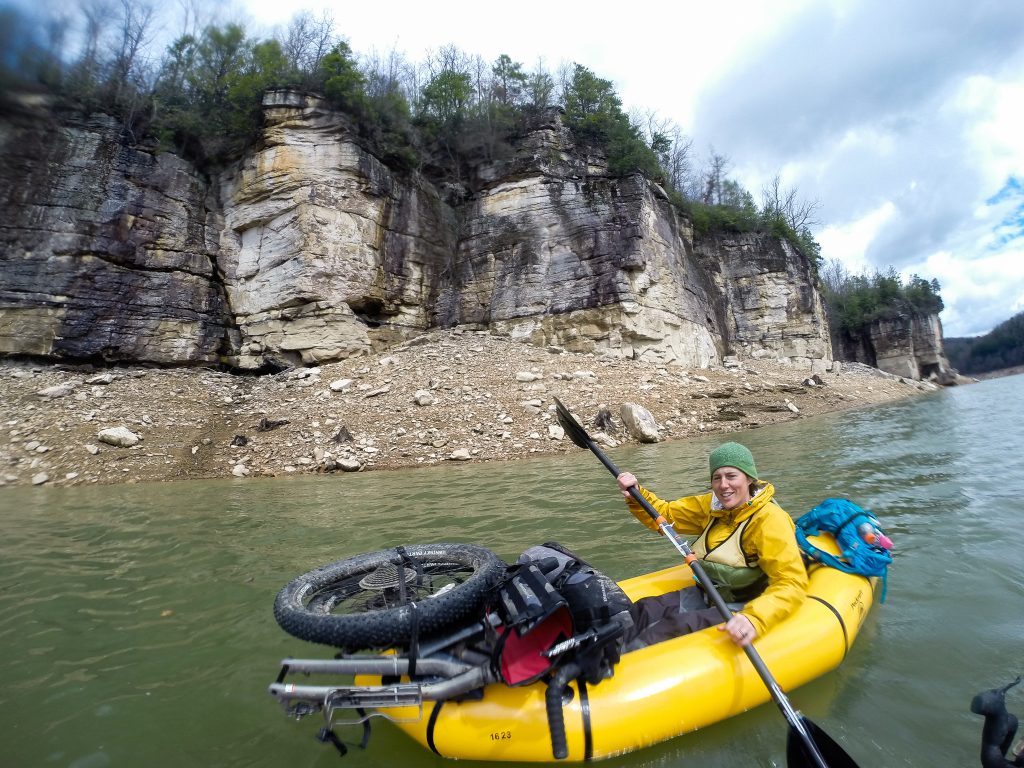
Finally, we were floating. It wasn’t the downriver paddling adventure we had in mind, but still, we were on the water. Sandstone cliffs towered above us, reminding me of how very small we are compared to the natural world. And if those stoic rock formations hadn’t been enough of a reminder, the wind most definitely was.
For two hours, we paddled into an angry headwind that only increased in intensity around every bend. The lake’s normally placid water lapped up and over the tubes of my packraft (which is not self-bailing). It took every ounce of dwindling energy I had to keep paddling. Stopping was not an option, for any lapse in forward motion would give the wind a chance to push us back.
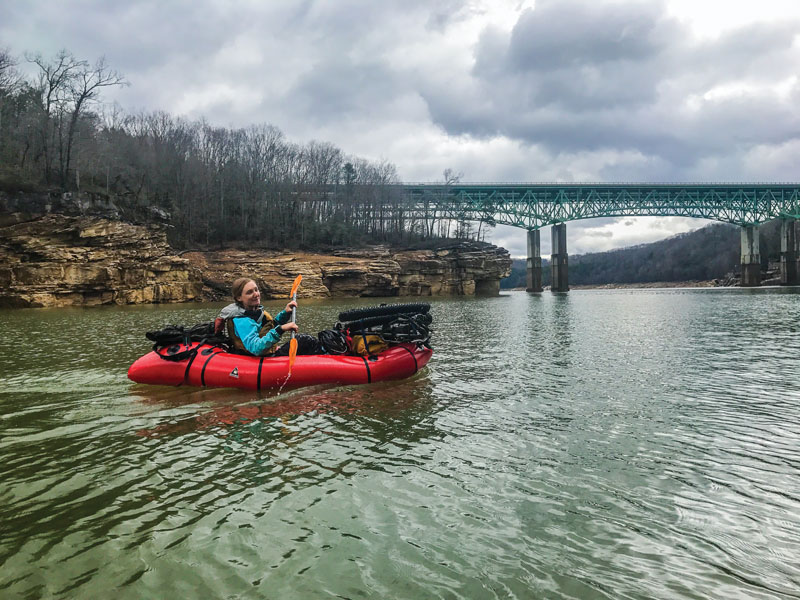
Parched, spent, and nearing the limits of my patience, we finally landed at a beach just above the Summersville Dam. In an hour we had assembled our bikes again and were headed down the road. Were it not for the hot and noisy ride along Route 19 back to Fayetteville, I might have reveled more in our multisport success. After all, the packraft truly did add another element to the bikepacking adventure. But in the moment, I had three things on my mind—pizza, root beer, and a dry set of clothes.
[nextpage title=”WANNA TAKE UP PACKRAFTING? READ ON!”]
PACKRAFTING 101
Know before you go!
Check out these 10 tips before you hit the water in a packraft.
Connect with other packrafters.
Packrafters are a rare and enthusiastic breed of outdoor enthusiasts. Check out the forums on the American Packraft Association’s website to ask questions, learn more tricks, and find beta on river trips near you.
Don’t buy a packraft before you’ve actually paddled one.
The average packraft falls somewhere in the $800-$1000 range, which is a pretty penny for people just looking to get into the sport. A much cheaper, and smarter, alternative is to rent a packraft from Packraft America. Rates start at $30 per day for a five- or six-day rental.
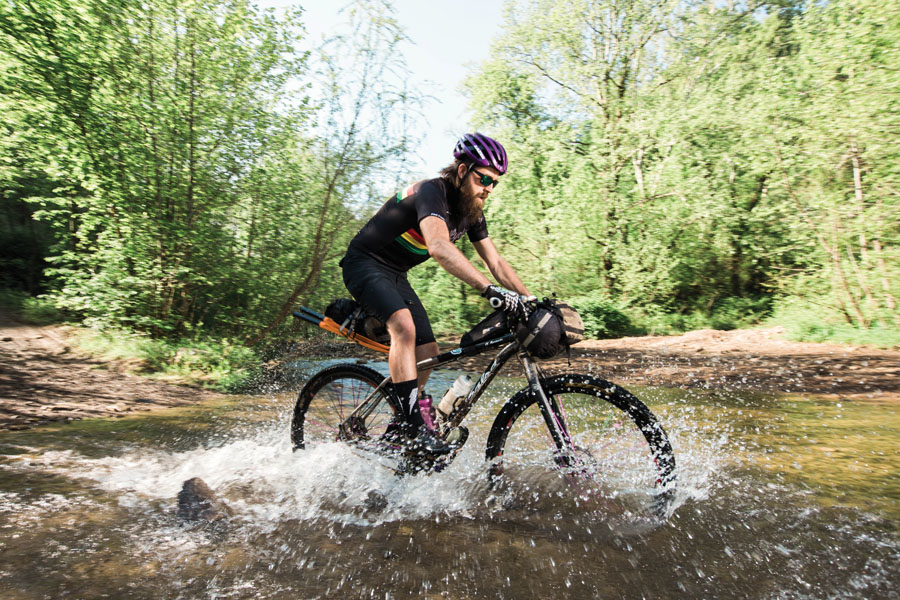
Bring a proper repair kit.
Prepare for the worst. If you’re biking, this includes materials and tools to repair not just your raft but your bike, too. “I always carry Tyvek tape and some AquaSeal,” says Spencer Williamson, Kennicott Wilderness Guides packraft instructor and Brevard Wilderness Leadership and Experiential Education graduate.
Pack light.
This is especially important if you’re planning a bikepacking packrafting trip, as heavy bike frames can easily max out the packraft’s weight limits. Try to keep the weight of food and gear under 50 pounds total so you don’t sink the ship.
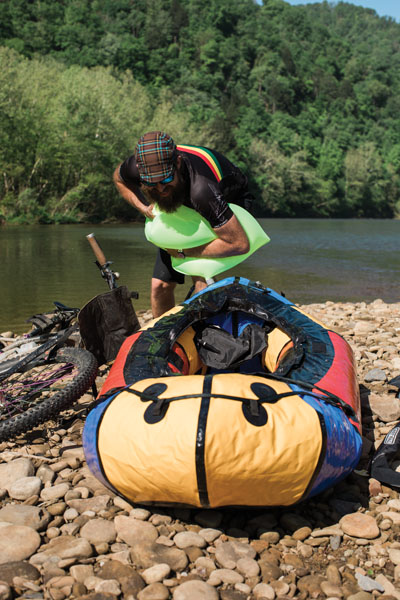
Invest in dry bags.
It’s okay to be thrifty, but if you’re going to take the cheap road, don’t do it with your storage bags. Nothing sucks more than getting off the bike at the end of a long wet day and discovering your “dry” set of clothes and sleeping bag are now sopping wet.
Have straps. Lots of ‘em.
A basic array of dry bags and cam straps are sufficient to get you through your early adventures.
Take a swiftwater course.
Or, at the very least, join a local paddling club to get some hands-on whitewater paddling experience, says Roman Dial, author of Packrafting! An Introduction and How-To Guide. “Packrafting is still sorta a new sport,” says Dial. “You need to know how to swim, throw a throwbag, and ferry.”
Make a Plan B.
Any good adventure never goes according to plan. So when four inches of rain dump on the river you’re planning to paddle, it’s smart to have an alternate route in mind.
Know the forecast.
Rivers can rise and fall dramatically over a short period of time. Keep your eyes on the forecast before you set off, and if you’re unable to check the weather while you’re in the woods, ask a local if you should so happen to cross paths with one.
Ask a local.
Even though Andy was our bonafide West Virginia local, he stopped to ask for directions. If there’s a short cut or a scenic route or a road closure, the locals will know about it. They might look at you like you’re crazy, but you are, so own it.
Pack It In, Pack It Out
Whether you’re a hiker or biker, these trail-to-river trips are the perfect introduction to packrafting in the Southeast and Mid-Atlantic.
[nextpage title=”READ ON FOR TIPS ON WHERE TO PACKRAFT IN THE BLULE RIDGE”]
Where to go!
New River Trail State Park + New River
Fries, Virginia
Trail Distance: 19 miles
River Distance: 32 miles
Difficulty: Beginner trail, class I-III river
Winding for 59 miles in southwestern Virginia, the New River Trail State Park is a linear multiuse park that parallels its namesake, the New River, for 39 miles. In its former life, the New River Trail was a railroad right-of-way, which makes the present-day trail well graded and easy on the legs. With a number of boat launches, primitive campgrounds, and parking lots up and down the trail, crafting your own packrafting adventure is a logistical cakewalk.
For a weekend overnighter, park in Allisonia. Strap a pack on or load up the bike. It’s 13.5 miles to Fries Junction, where you can pitch a tent for the evening. In the morning, it’s 5.5 more miles to the boat launch in Fries, where you’ll blow up the packraft and float back downstream to your car at Allisonia.
Greenbrier River Trail + Greenbrier River
Cass, West Virginia
Trail Distance: 9.4 miles
River Distance: 10 miles
Difficulty: Beginner trail, class I-II river
Though a few miles in the southern district of the Greenbrier River Trail are still closed due to heavy damage from the historic summer floods of 2016, the many miles north between milepost 13 and milepost 80.4 are untouched.
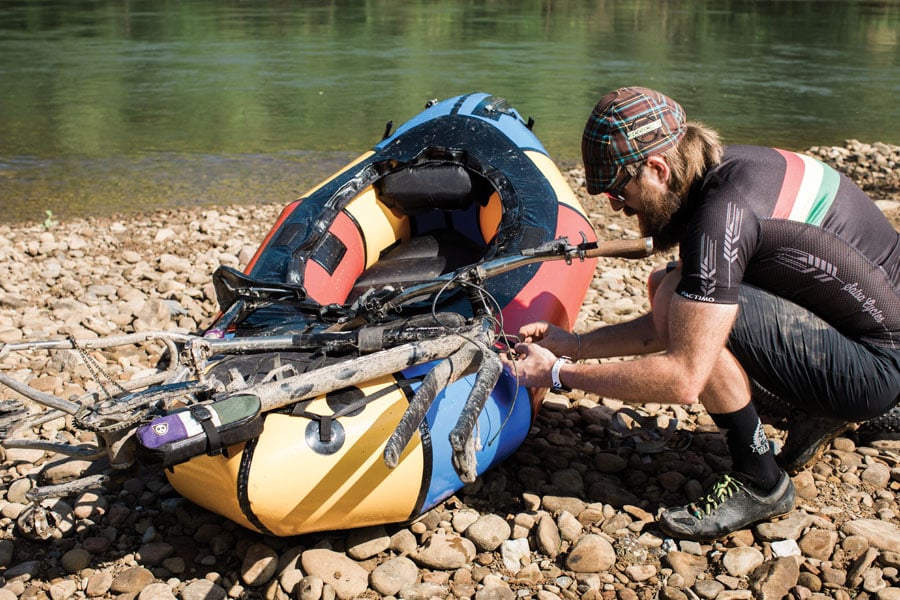
Take a long day in the woods and put in on the Greenbrier River in Cass. It’s a 10-mile float downstream to Clover Lick. The river here quietly meanders through the Monongahela National Forest, and though the rapids are small, the opportunities for fishing are aplenty. Once you take out at Clover Lick, roll up the raft, cinch it to your pack or bike, and hit the trail. It’s 10 easy miles back to your starting point in Cass, the literal end of the line for the Greenbrier River Trail. Extend your trip with ease by paddling farther downstream and utilizing one of the trail system’s numerous established campgrounds or trailside camping.
Big South Fork National River and Recreation Area
Stearns, Kentucky
Trail Distance: 7 miles
River Distance: 10 miles
Difficulty: Intermediate-advanced trail, class I-III river
Spanning 125,000 rugged miles across the Cumberland Plateau and over the Tennessee/Kentucky border, the Big South Fork National River and Recreation Area is revered for its remoteness and wild, pristine beauty. Unlike the rail-trail trips suggested above, this itinerary is recommended for more experienced trail and river users. Though most of the Big South Fork of the Cumberland River is flat, there are a couple of larger rapids, namely, a class IV chute called Devil’s Jump. This rapid can be easily avoided by portaging around it on river left.
Park at the Ledbetter trailhead to begin your adventure. As of 2013, the Ledbetter Trail was opened to mountain bikes, so you can ride or walk the two miles south to where trail meets river. After some light bushwhacking to get to the river’s edge, switch gears and load up the raft. The riverside camping here is phenomenal, but be sure to choose a site that is elevated enough to keep you safe from the possibility of rising water levels. Your takeout is at Blue Heron on river right just below Devil’s Jump (which can be identified by the overlook tower above it on river right). Once you’ve packed up the raft, head back over the river toward Dick Gap and Big Spring Falls to your car at Ledbetter.
Potomac River + Chesapeake & Ohio Canal
Harpers Ferry, West Virginia
Trail Distance: 16.7 miles
River Distance: 18 miles
Difficulty: Beginner trail, class I-II river
Riding or walking along this part of the Chesapeake & Ohio Canal is part history field trip, part adventure. Running for 184.5 miles in total, the C&O Canal traverses the Potomac River towpath, which once served as the economic and transportation lifeblood of the Mid-Atlantic.
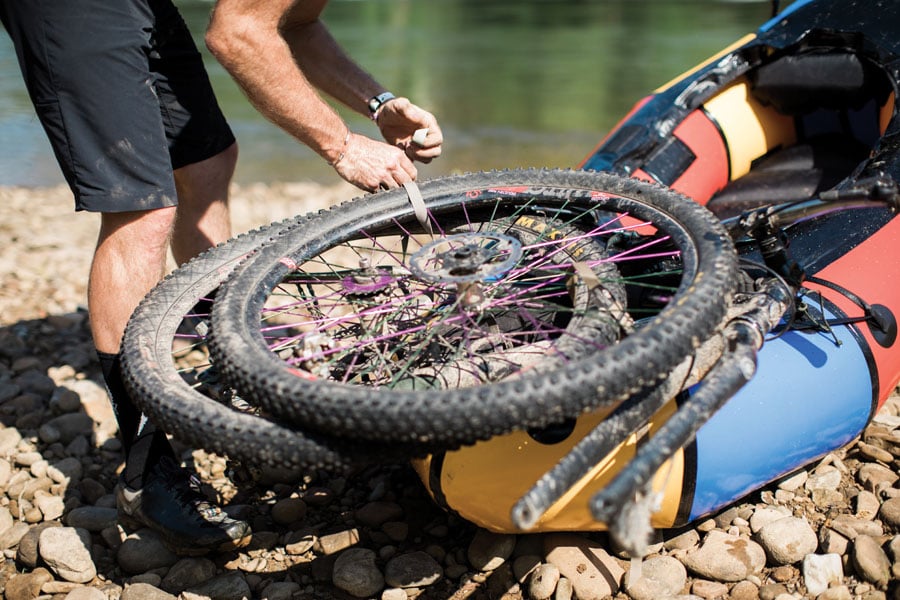
Begin your multisport adventure by parking at the Dargan Bend boat launch just outside of Harpers Ferry. Once you’ve inflated the raft and secured your return transportation of choice, be it a pair of hiking boots or a bike, it’s time to hit the water. The Potomac is relatively mild with the exception of a two-mile class II stretch of whitewater between Dam 3 and Sandy Hook. Continue on for another 13 miles past Sandy Hook under the Route 340 bridge to Point of Rocks. There will be plenty of prime camping spots before you reach Point of Rocks—we recommend checking out Bald Eagle Island for some truly unique riverside camping. Once you take out, pack up the raft and hit the C&O Canal for a breezy ride back to Dargan Bend.
Great Allegheny Passage + Youghiogheny River
Ohiopyle, Pennsylvania
Trail Distance: 12 miles
River Distance: 9 miles
Difficulty: Beginner trail, class II river
Hidden in the folds of southwestern Pennsylvania’s ridges and valleys is the bustling whitewater hub of Ohiopyle. With a year-round population just shy of 100, what this quaint town lacks in full-time residents it makes up for in its seasonal paddling scene, which attracts some of the world’s best whitewater athletes. The most popular stretches of the Youghiogheny River here are the Lower and Upper, but for low river traffic and beginner friendly rapids, take to the Middle section.
Park in the nearby town of Confluence, where you’ll launch your packraft adventure. From there it’s a mellow but fun nine-mile float to Ohiopyle. When you see an abrupt horizon line, that means you’ve arrived at Ohiopyle Falls. Take out on river left before plummeting over the 18-foot waterfall, which is technically allowed but only during certain times of the season. Deflate the raft, roll it up, and head back to Confluence via the Great Allegheny Passage. Don’t be surprised if your hike or ride feels especially slow—the slight uphill gradient can be deceptively taxing.
South Fork Holston River + Virginia Creeper Trail
Damascus, Virginia
Trail Distance: 32-41 miles
River Distance: 8-14 miles
Difficulty: Beginner trail, class II-III river
The classic Virginia Creeper Trail experience goes like this: hire an outfitter for a shuttle ride to the top, cruise 17 miles downhill back to Damascus, be home in time for supper. A much more interesting way to experience the same trail, and then some, is to incorporate the river that runs alongside it—the South Fork of the Holston River.
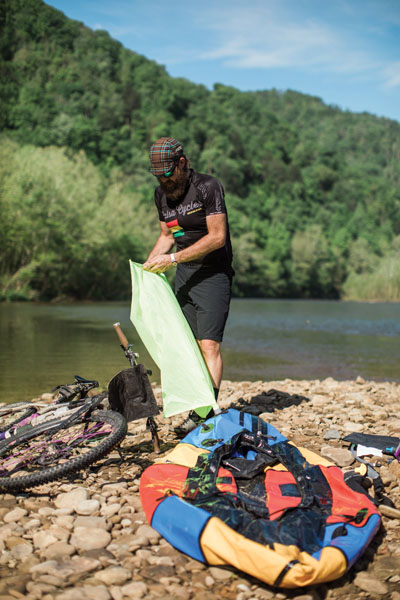
Stash your car just outside of Damascus at Alvarado Station. Once you’re packed, head upstream. If you’re on a bike and not pressed for time, we recommend climbing to the trail’s terminus at Whitetop Station, about 26 miles from Alvarado. The trail climbs gradually and parallels the idyllic Whitetop Laurel Creek, so take your time and soak in the rhododendron-packed scenery. Camping is available for free along most portions of the trail, so long as it’s not clearly marked private property. In the morning, enjoy an effortless cruise back to Damascus, where you’ll put in on the South Fork of the Holston River below the Drowning Ford bridge. Depending on water levels, you can put on the river right downtown and add a few extra miles to your float. The continuous class II-III rapids are easy to scout from the bank or read-and-run. You’ll be back in Alvarado before you know it.
Shenandoah River + Appalachian Trail
Waynesboro—Front Royal, Virginia
Trail Distance: 107.8 miles
River Distance: 95 miles
Difficulty: Intermediate-advanced trail, class I-II river
Looking to spend your precious vacation time on some hard-earned memories? Enter the region’s ultimate packrafting adventure. Popular among Appalachian Trail thru hikers as an “aqua blaze” alternative to hiking through the Shenandoahs, this portion of the Shenandoah River is floatable pretty much year-round. The outfitters between Waynesboro and Front Royal, Virginia, are accustomed to hikers ditching their boots for a canoe, but you won’t need to do either. You will, however, be required to thumb a ride. But what’s an Appalachian Trail hike without a little hitchhiking?
Park near the Rockfish Gap Entrance to Skyline Drive where the Appalachian Trail crosses Afton Mountain. You can either arrange for a shuttle to pick you up off the mountain, or thumb a ride to the Port Republic boat launch a half-hour away. You can also put on the South River, a tributary to the Shenandoah, closer by in Waynesboro, but that will add some substantial distance to the packrafting portion. For the next few days, you’ll be floating the South Fork of the Shenandoah River. Camping is available anywhere that’s not designated private property. Your takeout is the Karo boat launch just outside of Front Royal. Once in town, you can hop on public transportation which makes routine stops to where the Appalachian Trail crosses US-522. Follow the white blaze south back to Rockfish Gap.
French Broad + French Broad River Greenway
Asheville, North Carolina
Trail Distance: 2.83 miles
River Distance: 2.4 miles
Difficulty: Beginner trail, class I river
The French Broad River cuts right through the heart of Asheville and, as such, is fast becoming the city’s pride and joy. On any given summer day, the river is packed with inner tubers and paddlers out for a day float. Some of that energy is no doubt thanks to new greenway plans and riverfront development.
Explore just a taste of the 140-mile long river where it winds below West Asheville. Park at Hominy Creek River Park and load up the raft. You won’t find many rapids here, as opposed to section 9 of the Broad, but this calm stretch of water is perfect for first-time floaters and families. Your takeout is just a couple of miles downstream at the French Broad River Park where you can hike or bike along the French Broad River Greenway and be back at Hominy Creek all in a day’s time.
Lower Green River + Green River Game Lands
Saluda, North Carolina
Trail Distance: 1.75 miles
River Distance: 6 miles
Difficulty: Intermediate trail, class II river
Step up your packrafting game on the Lower Green River in western North Carolina. A gem of a run largely recognized for the class V Narrows section farther upstream, the Lower Green itself is a great float for boaters of all disciplines wanting to learn more about paddling in current.
Put in at the Fishtop Access parking lot on Green Cove Road. It’s impossible to miss, and will likely be packed with kayakers taking off the river after running the Narrows. From here it’s a pleasant six-mile float down to the takeout, if you’re willing to do a little road walking afterwards. If you’d rather skip the road walk, take out on river left when you see Green Cove Road cross the river. The Green River Cove Trail traces the winding path of the Green River back toward Fishtop. You may need to inflate your raft to ferry back over the river to the parking lot, but that’s the beauty of a packraft—it’s there when you need it most.
Cumberland River + Cumberland River Bicentennial Trail
Ashland City, Tennessee
Trail Distance: 6.7 miles
River Distance: 6 miles
Difficulty: Beginner trail, class I river
Floating along the Cumberland River near Ashland City, you’d never know you were just 30 minutes away from the metropolis that is Nashville, Tennessee. Bordered on one side by the 20,000-acre Cheatham Wildlife Management Area and the Dyson Ditch Wildlife Refuge on the other, the river here is a sanctuary for urban dwellers and wildlife alike.
Park a car at the Marks Creek trailhead parking lot for the Cumberland River Bicentennial Trail. Whether you’re riding a bike or walking, you’ll need to make your way down Chapmansboro Road toward the river, where you can inflate your packraft and head downstream. It’s a lazy float for almost six miles down to the Cheatham Dam boat launch on river right. Hop out here and head up the street to the end terminus of the Bicentennial Trail. After a short jaunt along half graded gravel, half paved trail, you’re back where you started. It’s the ideal day trip escape from the bustle of city life.
